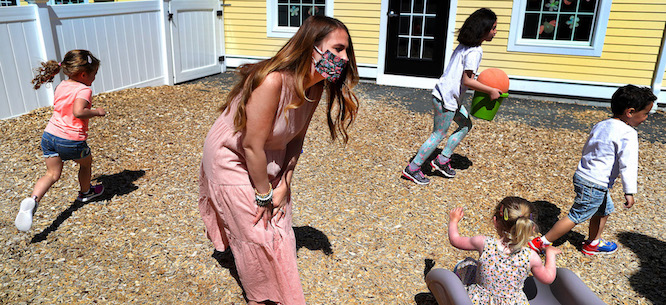Family Child-Care Providers Unionize in California
Family Child-Care Providers Unionize in California
Rosa Carreño hopes her new union will lead to more support from the state. “The parents can’t go to work if they don’t have a safe place for their children to stay.”

In California the pandemic and the accompanying recession forced many day cares to shut down, and the providers still open are burdened by declining enrollment and the cost of required sanitary and safety measures. Yet the unprecedented challenges for the sector have also paralleled a long-anticipated union victory, one that could change the way child care is delivered to working-class communities across the state.
The estimated 40,000 family child-care providers across California—a mostly female workforce running home-based day cares and early childhood education programs—voted overwhelmingly to unionize in July, capping an extensive organizing effort led by two of the state’s largest service-worker unions, Service Employees International Union and American Federation of State, County and Municipal Employees. The vote was enabled by legislation that passed last September, which allowed state-supported child-care providers to collectively bargain with the state, making California one of just a dozen states that grant these workers such rights.
Rosa Carreño has been organizing for a union for about as long as she’s been in the business. Twenty years ago when she started a day care in her home, serving children ranging from newborns to fourteen-year-olds, she became frustrated with the bureaucracy that administered child-care subsidies to low-income families. She recalled how parents would have their subsidies abruptly cut off because they lost eligibility without any clear explanation: “The parents [handed in] paperwork, and the agency [said], ‘Well, we don’t have the paperwork, so you’re going to lose your child care.’” She started to become more active in advocating for more support for child-care providers, and by extension, more support for the families who struggle to afford quality child care.
Now that they have a union, she hopes that the workers can negotiate a contract that offers basic economic security, including a living wage and healthcare. Since family child-care homes like Carreño’s are paid a set amount for each child in their care—a piecework scheme that leaves many providers barely able to meet the basic needs of their own families—their economic well-being is intertwined with the state’s support for working-class families. Annual costs for preschool-age kids enrolled in a family child-care home were around $9,000 in the fiscal year 2017, according to the California Budget and Policy Center, about a third of a full-time minimum-wage income in California today. The state’s current funding levels serve fewer than one in four of the three-to-five-year-olds who are eligible for a subsidy. The working-class households who are fortunate enough to have a child-care voucher generally depend on a subsidy of a couple hundred dollars per week for a toddler.
“Once we sit down to negotiate our contract, we are asking for better pay,” Carreño said. “We are asking for benefits.”
These days, home-based child-care providers must put in extra hours and cash to clean and sanitize their facilities, which are simply a section of their homes they have converted into their workplace. For Carreño, masks and social distancing have become as much a part of the routine as playtime and lessons. She said she was trying to teach the children in smaller groups and let them play outside in the fresh air as much as possible to help minimize infection risks.
But her business—which, unlike other day cares, never shut down during the pandemic—continues against a tense backdrop.
“There’s a lot of providers that have become infected with the virus [and] there’s a lot of them that have closed,” she said.
In a survey by the University of California-Berkeley’s Center for the Study of Child Care Employment, about three-quarters of family child-care providers who closed during the pandemic cited concerns that “their family’s health was at risk.”
Meanwhile, many of the parents she serves work in settings where they are highly exposed to the virus, such as retail, hotels, or construction.
While California as a whole is facing major fiscal decline, family child-care providers managed to avoid significant cuts in the latest state budget, and Governor Gavin Newsom expanded funding for child-care subsidies for the state’s “essential workers.”
But while that extra funding might help child-care providers like Carreño keep their doors open, she is still barely able to cover her costs. “I have a paycheck coming in,” she said. “But by the time my paycheck arrives, I have to send it out. Because I have a house payment, I have insurance payments, I have day-care insurance, I have all kinds of stuff that I need to pay out.”
She hopes her new union will help persuade the state government to respect the interdependence between child-care providers and other essential workers. “If we’re not well taken care of, and we don’t have what we need, it’s not just our world that is affected, it’s everybody,” she said. “The parents can’t go to work if they don’t have a safe place for their children to stay.”
Correction: An earlier version of this article misspelled Carreño’s name. We regret the error.
Michelle Chen is a member of Dissent’s editorial board and co-host of its Belabored podcast.





